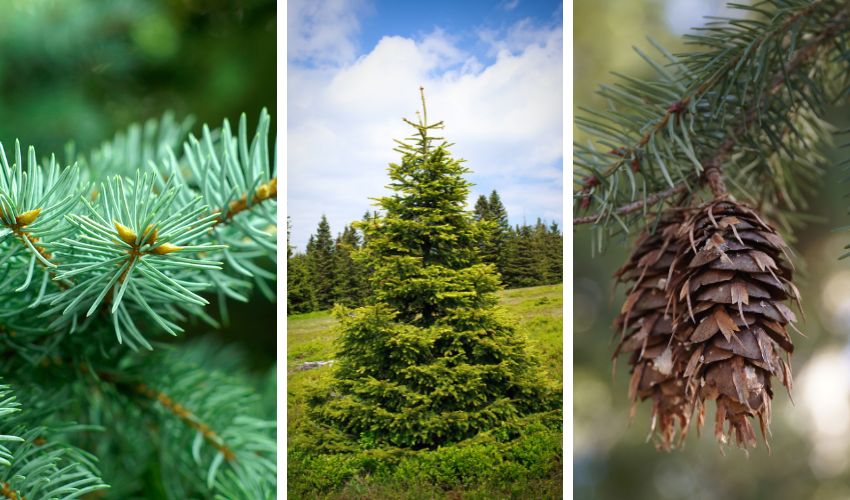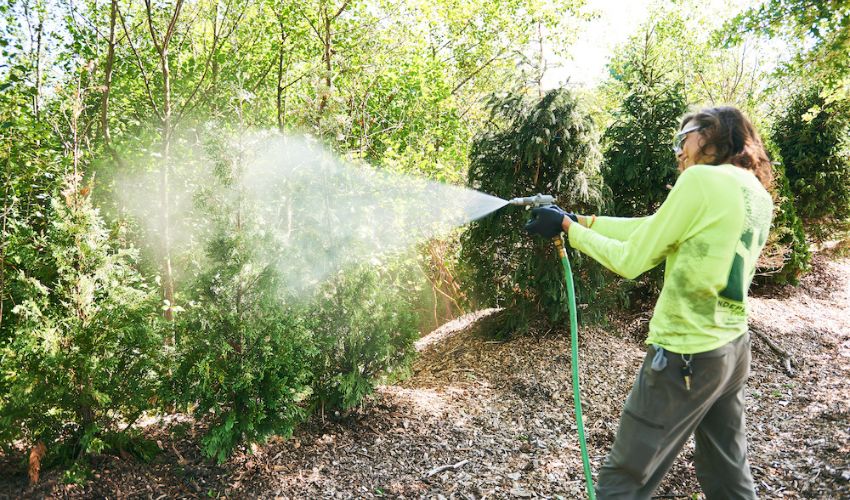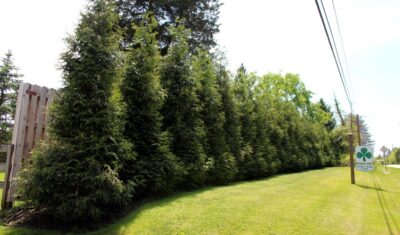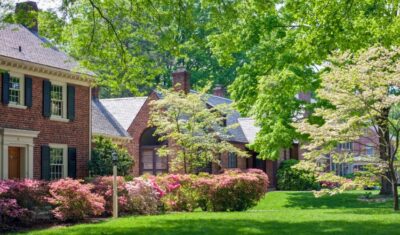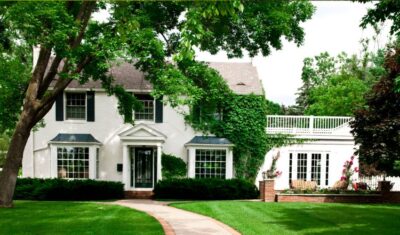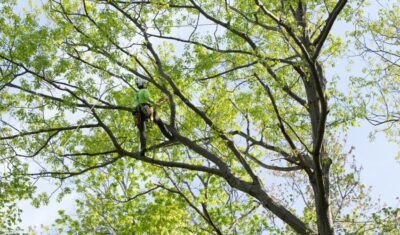Several varieties of spruce trees can be found throughout Northeast Ohio, both native and non-native types. These conifer trees are an important part of our landscape and serve as a windbreak, shelter for birds and wildlife, and point of interest on your property.
However, spruce trees can suffer from many different pest and disease issues, especially if they suffer from stress caused by drought, insufficient nutrients, or being planted in an incorrect location.
In this article, we’ll go over some of the most common spruce trees you will find in our area, some issues that they deal with, and how you can prevent, recognize, and treat these issues.
Do You Have Spruce Trees on Your Property?
Before discussing the different issues affecting spruce trees, it is important to recognize if you have one on your property. Many conifer trees are incorrectly referred to as “pine trees,” but spruce trees differ from pine, fir, and other conifer trees in several ways.
Here’s how you can determine if your conifers are spruce trees:
- Check the needles. They might be spruce if they have four sides you can roll easily between your fingers.
- Observe how the needles are attached to the branch. If they are attached individually rather than in a cluster, they may be spruce.
- Look at the cones. Spruce cones are covered with smooth, thin scales.
- If you view the tree’s shape, spruce trees have full, bushy foliage with branches that grow upwards.
There are over 30 spruce tree varieties found around the world, but spruce trees most often planted or found in Ohio include:
- Blue spruce or Colorado spruce (Picea pungens)
- Norway spruce (Picea abies)
- Siberian spruce (Picea obovata)
- Dwarf Alberta spruce (Picea glauca ‘Conica’)
- White spruce (Picea glauca)
While spruce trees are popular in Ohio, they have several health issues. These issues are becoming increasingly noticeable, to the point that it is sometimes referred to as “spruce decline.”
Interestingly, almost all pests and diseases that impact spruce trees are discovered when needles change color and drop prematurely. Scheduling a professional tree consultation is the best way to determine the issue and how it can be treated.
Learn other reasons why conifers lose or drop their needles >>
Common Spruce Tree Diseases in Northeast Ohio
Below are some diseases most often found on spruce trees in Northeast Ohio.
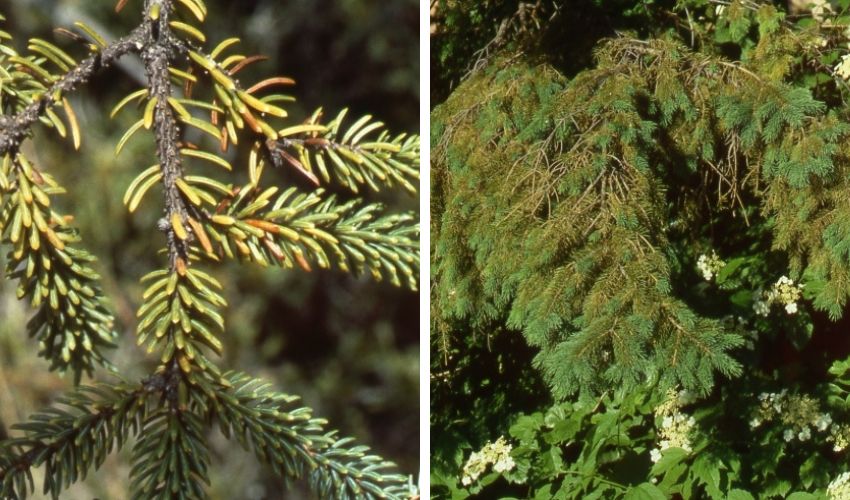
Images of Rhizosphaera needle cast on white spruce courtesy of Joseph O’Brian, USDA Forest Service, Bugwood.org.
Rhizosphaera Needle Cast
If your spruce’s needles have yellow or red blotches, turn purplish-brown, or drop prematurely, Rhizosphaera needle cast may be to blame.
Caused by a fungus, Rhizosphaera needle cast is often caused by warm, wet weather in spring through fall.
Stigmina Needle Cast
Similar to Rhizopheaera needle cast, stigmina needle cast can be spotted by needles changing color and foliage thinning. In fact, it can be hard to determine which needle cast affects your spruce trees without a microscope.
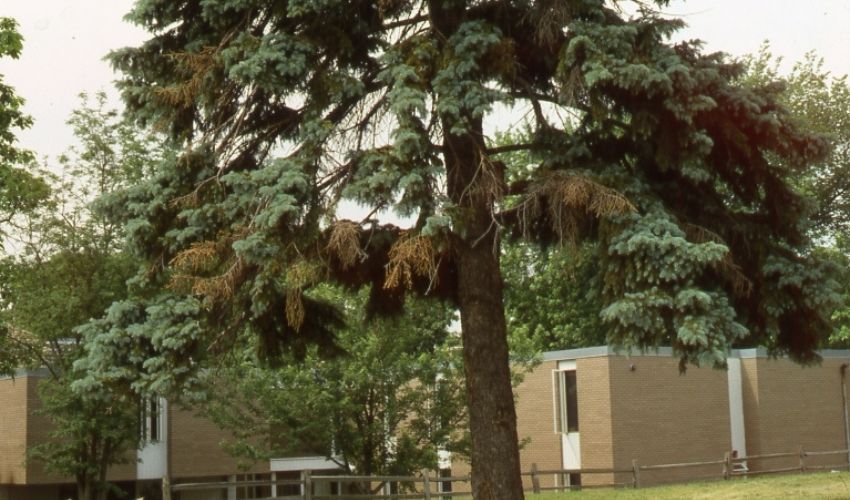
Image of Cytospora canker on the lower branches of a blue spruce courtesy of Joseph O’Brian, USDA Forest Service, Bugwood.org.
Cytospora Canker
If spruce needles turn purple or brown or fall off your tree’s lowest branches, it may suffer from Cytospora canker.
Cytospora canker is a fungal disease affecting Norway and Colorado blue spruce trees, most often those older than 15 years.
Phomopsis Canker
Similar to Cytospora canker, Phomopsis canker can cause branch dieback. Previously, Cytospora canker was assumed to be the cause in all instances, but Phomopsis canker is becoming increasingly prevalent.
This disease usually begins at the bottom of the tree canopy and moves upward as more needles turn brown and drop, and the branches die.
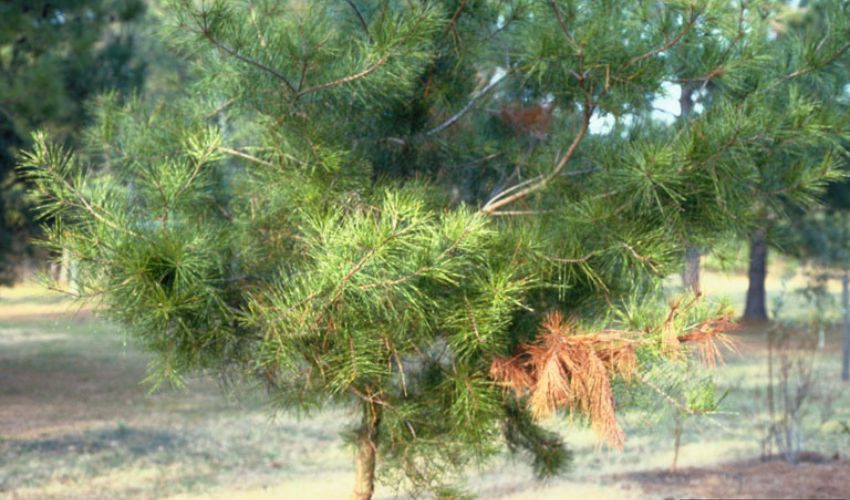
Image of diplodia tip blight courtesy of Edward L. Barnard, Florida Department of Agriculture and Consumer Services, Bugwood.org.
Diplodia Tip Blight
Branch tips turning brown, branches dying, and the tree becoming deformed can be signs of another fungal disease, diplodia tip blight. You may also notice some fungal fruits on the tree cones.
Common Spruce Tree Pests in Northeast Ohio
Spruce trees are not only impacted by diseases but by insect pests as well. Below are some of the most common insect pests that impact spruce trees in Northeast Ohio.
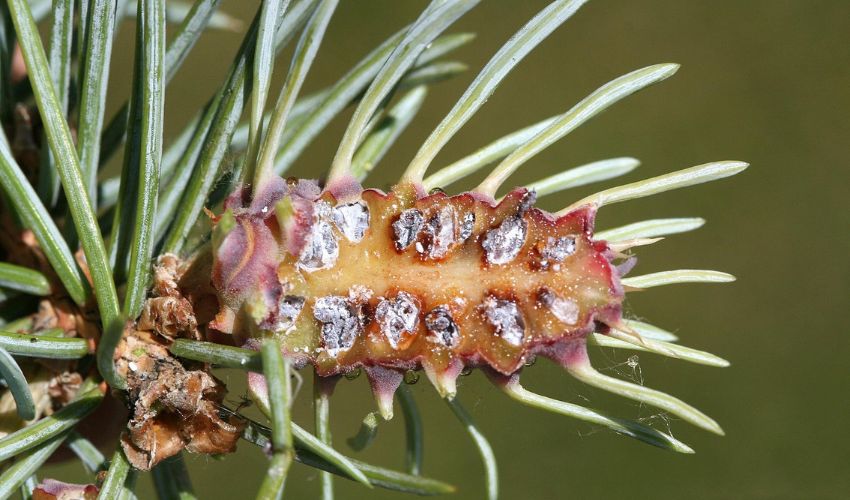
Image of cooley spruce gall adelgid courtesy of Whitney Cranshaw, Colorado State University, Bugwood.org.
Cooley and Eastern Spruce Gall
Various types of spruce trees are impacted by an adelgid (similar to an aphid), which produces galls shaped like tiny pineapples.
Read more about galls on trees >>
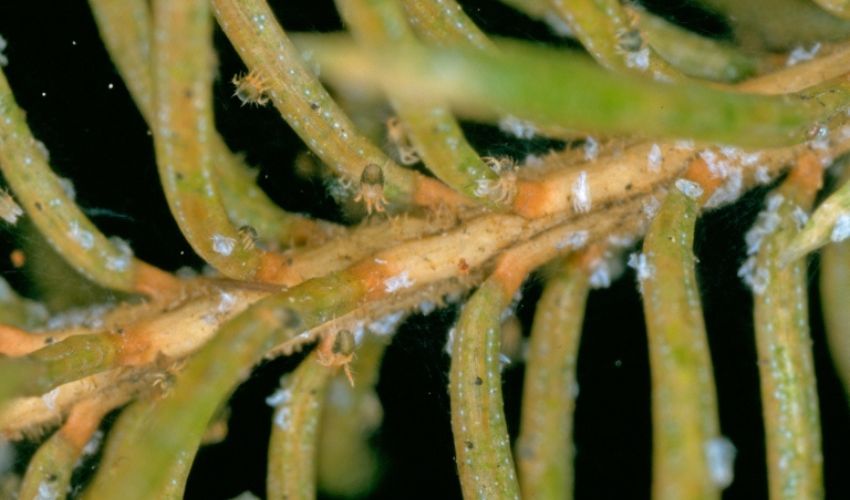
Image of spruce spider mites courtesy of Petr Kapitola, Central Institute for Supervising and Testing in Agriculture, Bugwood.org.
Spruce Spider Mites
Imagine an insect so tiny that a full-grown adult is merely 1/50th of an inch: That is a spider mite. You may not spot these pests with your bare eye, but you will undoubtedly spot the damage they leave in their wake.
If infected by spruce spider mites, spruce tree needles will become mottled or might turn pale yellow or red. The infected needles will eventually drop to the ground. Sometimes, small webs can be observed on the needles during spring, summer, or fall.
Though spruce spider mite eggs hatch in March and April, signs of damage may not appear until summer.
Learn more about spider mites and other summer pests >>
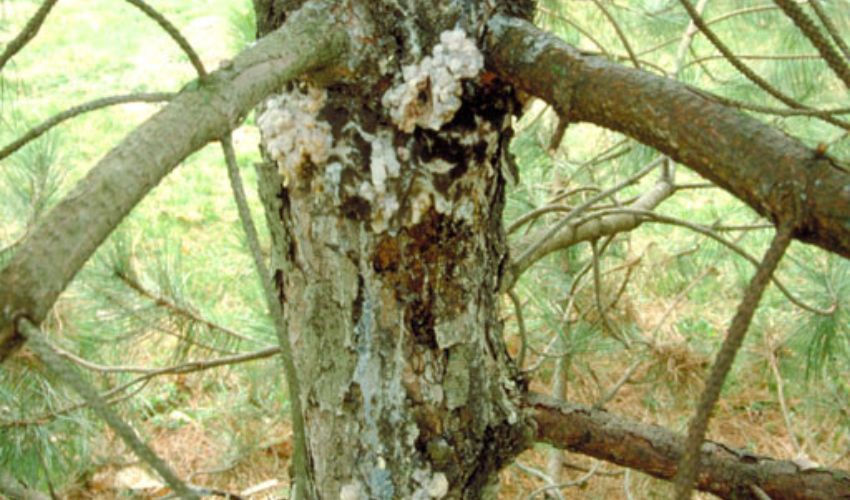
Image of pitch mass borer damage courtesy of Eric R. Day, Virginia Polytechnic Institute and State University, Bugwood.org
Pitch Mass Borer
Borers are insects that attack trees by drilling holes into them and laying eggs on the bark. If you notice a random pattern of holes in your tree’s bark, it may be caused by a pitch mass borer. Sap often flows from these holes as the tree attempts to protect itself.
The larvae that hatch on spruce trees will feed on the inner bark and sapwood, causing a flow of pitch that hardens on the bark.
White Pine Weevil
If the top of your spruce tree is wilting and turning brown, the white pine weevil may be to blame.
Female white pine weevils lay eggs in spring on branch tips at the top of the tree, boring holes into the tree. When the eggs hatch, the larvae tunnel under the bark, feeding on it. This cuts off the water and nutrients to that part of the turn, which is why the tops turn brown, look wilted or curved, and eventually die.
Learn more about white pine weevils and how they impact spruce trees >>
How Can You Keep Your Spruce Trees Healthy?
Several issues are contributing to the decline of spruce trees in Ohio. Weather conditions, trees being planted in the wrong locations, increases in pest populations, and more have all contributed to the increase in issues with spruce trees.
Plant Native Spruce Trees
Blue spruce, one of the most common spruce trees in Ohio, is actually native to the mountains of Colorado, an area with different soil, weather, humidity, and growing conditions. Unlike windy and arid Colorado, Ohio often has more humid weather, leading to many of the fungal diseases we mentioned above.
Ensure Your Spruce Trees Have the Resources They Need
Many spruce tree issues can be prevented by ensuring your trees receive adequate water, sunlight, and nutrients to thrive.
Watering your spruce trees during extended periods of drought can prevent them from becoming unduly stressed, which can then prevent certain pests from attacking an already weakened tree.
Fertilization, especially deep-root fertilization, can ensure that your spruce trees receive the nutrients they need to thrive, especially in urban and suburban locations.
Adding mulch can also provide nutrients, regulate soil temperatures, and improve the moisture of the soil around spruce trees.
Use Tree Health Care Services Before You Spot Any Issues
Independent Tree offers tree health care services to prevent the pests and diseases discussed in this article (along with many others!).
Most issues that impact spruce trees in Northeast Ohio can be prevented with treatments such as horticultural oils and fungicide applications.
Treating pests and diseases is more impactful before you notice any issues, but some can still be treated even after your trees begin to show signs of distress.
Contact Independent Tree to schedule a tree health care inspection for your property.
Keep Your Trees Well-Maintained
Scheduling regular tree care services, such as pruning, tree health inspections, fertilizations, and any other needed treatments, is an important part of keeping your spruce trees healthy and beautiful.
Do you have a spruce tree?
Contact Independent Tree today to schedule an inspection to check for any issues.Recent Articles
Topics
About The Author

STAY IN THE LOOP
WITH OUR
LATEST UPDATES
"*" indicates required fields

